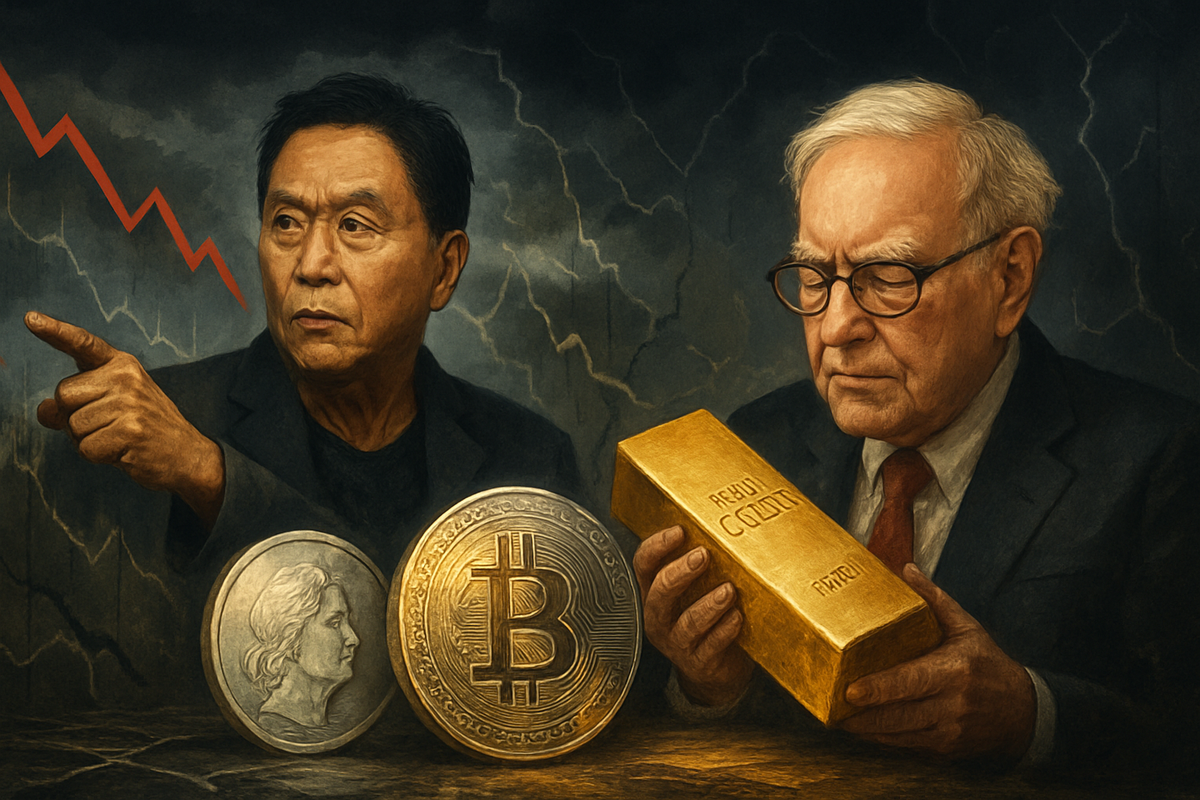
As the calendar turns to October 2025, a palpable sense of unease permeates global financial markets, fueled by dire predictions from renowned financial educator Robert Kiyosaki. The author of "Rich Dad Poor Dad" has consistently sounded the alarm, forecasting an impending "super-crash" that he warns could be the most catastrophic in history, eclipsing even the 2008 financial crisis. His pronouncements, centered on the year 2025 as a potential flashpoint, are compelling investors to re-evaluate their portfolios and consider alternative safe havens.
Kiyosaki's stark warnings are not isolated; they resonate within a broader landscape of economic uncertainty, marked by persistent inflation, the disruptive potential of artificial intelligence, and geopolitical tensions. While many traditional investors cling to established assets, Kiyosaki advocates a radical pivot towards "real money" – physical gold, silver, and select cryptocurrencies – as the only true bulwark against an economic meltdown. This contrarian stance gains an intriguing layer of validation from an unexpected quarter: legendary investor Warren Buffett, whose Berkshire Hathaway (NYSE: BRK.A) has historically been skeptical of precious metals, has recently shown a notable shift in sentiment towards gold, further fanning the flames of speculation about the market's stability.
The Looming 'Super-Crash': Kiyosaki's Dire Predictions and Buffett's Golden Shift
Robert Kiyosaki's predictions of a market collapse have been consistent and increasingly urgent. He has repeatedly pointed to 2025 as a critical year, with some warnings even pinpointing February 2025 for a potential "biggest crash in history" that could usher in a "New Great Depression." His core argument traces back to 1971, when the U.S. dollar was decoupled from the gold standard, which he believes severed currency from tangible value and laid the groundwork for systemic instability. He cites runaway inflation, the rapid job displacement potential of artificial intelligence, and what he perceives as a false sense of security offered by traditional financial advice and assets as primary catalysts for the impending crisis. Kiyosaki specifically cautions against reliance on traditional investments such as stocks, bonds, and real estate, going so far as to suggest that Baby Boomers' 401(k) retirement accounts could be decimated. He has also advised divesting from real estate while prices remain elevated.
Adding significant weight to the narrative of impending instability is the evolving stance of Warren Buffett, Chairman and CEO of Berkshire Hathaway (NYSE: BRK.A). For decades, Buffett famously dismissed gold as an unproductive asset, preferring investments in companies that generate earnings. However, a notable shift in his investment philosophy has been observed, particularly with Berkshire Hathaway's acquisition of Barrick Gold Corporation (NYSE: GOLD) shares in 2020, and subsequent adjustments to its precious metals holdings. While Berkshire Hathaway's overall portfolio remains heavily weighted towards equities, this move, however modest, was interpreted by many, including Kiyosaki, as a significant signal. Kiyosaki views Buffett's endorsement of gold and silver, after years of dismissing them, as a strong indicator that even the most conservative investors are recognizing serious problems brewing in traditional stock and bond markets. This shift by such an influential figure, even if temporary or strategic, contributes to heightened investor caution and a re-evaluation of diversification strategies amidst concerns over inflation, geopolitical instability, and a weakening dollar.
The immediate market reactions to such warnings are often a mix of heightened anxiety and a flight to perceived safety. While not all investors are liquidating traditional assets en masse, there is an observable trend of increased interest in hard assets. Gold prices have continued their upward trajectory, reaching record highs, and silver has seen significant surges, aligning with Kiyosaki's predictions of an "explosion" in silver prices by September 2025. Cryptocurrencies like Bitcoin (CRYPTO: BTC) and Ethereum (CRYPTO: ETH) have also experienced renewed interest, with Kiyosaki forecasting Bitcoin's value to reach $250,000 by 2025, anticipating a rush of capital from traditional markets into digital assets during a downturn. This confluence of expert warnings and market movements underscores a growing sentiment that the financial landscape is poised for significant change.
Potential Winners and Losers in a Shifting Economic Landscape
In an environment characterized by warnings of a market collapse and a pivot towards safe-haven assets, certain companies and sectors are positioned to either thrive or face significant challenges.
Potential Winners:
- Precious Metals Miners: Companies involved in the extraction and processing of gold and silver stand to benefit significantly. As the demand for physical gold and silver surges, driven by investor fear and a desire for tangible assets, the revenues and profitability of mining companies like Barrick Gold Corporation (NYSE: GOLD), Newmont Corporation (NYSE: NEM), and Wheaton Precious Metals Corp. (NYSE: WPM) could see substantial increases. Barrick Gold, already in the spotlight due to Berkshire Hathaway's past investment, could particularly benefit from continued investor confidence in gold.
- Cryptocurrency Exchanges and Related Services: With Robert Kiyosaki advocating for Bitcoin (CRYPTO: BTC) and Ethereum (CRYPTO: ETH) as "real assets," platforms that facilitate the buying, selling, and storage of cryptocurrencies are likely to see increased activity. Companies such as Coinbase Global, Inc. (NASDAQ: COIN) and MicroStrategy Incorporated (NASDAQ: MSTR), which holds a significant amount of Bitcoin on its balance sheet, could experience a surge in user engagement and asset appreciation.
- Defensive Sectors: In times of economic instability, consumer staples companies, which provide essential goods and services, often perform relatively well as demand remains stable. Companies like Procter & Gamble (NYSE: PG), Walmart (NYSE: WMT), and Coca-Cola (NYSE: KO) might be seen as safer bets as investors seek stability.
- Companies with Strong Balance Sheets and Low Debt: Businesses with robust cash reserves and minimal debt will be better equipped to weather economic downturns, potentially acquiring distressed assets at favorable prices or continuing operations without significant financial strain.
Potential Losers:
- Highly Leveraged Companies: Businesses burdened with substantial debt will face increased refinancing risks and higher interest expenses, particularly if credit markets tighten during a downturn. This vulnerability could lead to liquidity crises or even bankruptcy.
- Growth Stocks and Speculative Tech: Companies with high valuations based on future growth potential, particularly in the technology sector, are often the hardest hit during market corrections. Investors tend to rotate out of speculative assets into more stable investments, leading to sharp declines for many tech giants and emerging growth companies.
- Real Estate Developers and Mortgage Lenders: If Kiyosaki's warnings about real estate prove accurate, companies heavily invested in property development or those with significant exposure to mortgage lending could suffer from declining property values, reduced transaction volumes, and increased defaults.
- Financial Institutions (Banks): A widespread market collapse, particularly one affecting traditional assets like stocks and bonds, could lead to significant write-downs for banks (NYSE: JPM), (NYSE: BAC), (NYSE: WFC), increased loan defaults, and a tightening of credit markets, severely impacting their profitability and stability.
The shift in investor sentiment towards hard assets and defensive plays could fundamentally alter market dynamics, creating a clear divergence between assets perceived as safe havens and those deemed too risky in an unstable economic climate.
Broader Significance and Historical Echoes
The warnings from financial experts like Robert Kiyosaki, coupled with the nuanced shifts in investment strategies from figures like Warren Buffett, resonate deeply within broader industry trends and economic anxieties. This current climate is not merely a fleeting concern but rather fits into a larger narrative of increasing global economic fragility and a re-evaluation of traditional financial paradigms.
One significant trend is the persistent inflationary pressure observed across major economies. Central banks have grappled with rising prices, and while some measures have been taken to curb inflation, the underlying concerns about currency debasement persist. Kiyosaki's argument about the U.S. dollar's detachment from the gold standard in 1971 gains particular salience in this context, suggesting that current inflationary woes are a symptom of a deeper, systemic issue rather than a temporary blip. This narrative encourages a flight to tangible assets like gold and silver, which have historically served as hedges against inflation and currency depreciation.
The potential ripple effects on competitors and partners are substantial. If a significant market correction or collapse materializes, companies across all sectors will feel the impact. Financial institutions, in particular, would face immense pressure from potential loan defaults, reduced trading volumes, and a general loss of confidence. Supply chains, already strained by recent global events, could face further disruptions, affecting manufacturing and retail sectors. Conversely, companies providing essential goods and services (consumer staples) or those with robust balance sheets and minimal debt might find themselves in a relatively stronger position, potentially even gaining market share as weaker competitors falter.
Regulatory and policy implications are also profound. A severe market downturn would almost certainly trigger calls for increased government intervention and regulatory oversight. Policymakers might consider measures to stabilize financial markets, protect consumers, and stimulate economic activity. This could include new regulations on financial products, increased scrutiny of investment practices, or even direct fiscal stimulus packages. The debate around central bank digital currencies (CBDCs) might also intensify, as governments seek new ways to manage monetary policy and ensure financial stability in a volatile environment.
Historically, periods of extreme economic uncertainty have often seen a resurgence of interest in precious metals. The Great Depression of the 1930s, the inflationary periods of the 1970s, and the 2008 financial crisis all demonstrated gold's role as a safe-haven asset. The current situation draws parallels to these historical precedents, reinforcing the idea that in times of crisis, investors often return to assets with intrinsic value and a long history of preserving wealth. The difference today lies in the emergence of cryptocurrencies like Bitcoin (CRYPTO: BTC) as a new, digitally native "hard asset," which some proponents believe offers similar, if not superior, hedging capabilities to traditional precious metals. This introduces a new dynamic to the safe-haven discussion, complicating historical comparisons but also offering new avenues for diversification.
Navigating the Future: What Comes Next?
The confluence of dire market collapse warnings and a renewed focus on safe-haven assets sets the stage for a period of significant market volatility and strategic re-evaluation. In the short term, investors are likely to exhibit heightened caution, potentially leading to continued outflows from traditional equity and bond markets and sustained demand for gold, silver, and select cryptocurrencies. This could manifest as further upward pressure on the prices of these "real assets," while more speculative or overvalued segments of the stock market may experience corrections. Companies with strong fundamentals and defensive characteristics are expected to outperform, as investors prioritize stability over aggressive growth.
Looking further ahead, the long-term possibilities are diverse and hinge on the actualization and severity of the predicted market collapse. Should a significant downturn occur, we could see a profound restructuring of global financial markets. This might involve a deleveraging across various sectors, a re-pricing of assets to more realistic valuations, and a shift in economic power dynamics. For investors, this period would present both immense challenges and unprecedented opportunities. Those who have heeded warnings and diversified into hard assets or maintained significant cash reserves would be positioned to acquire distressed assets at substantial discounts, aligning with Kiyosaki's philosophy that "crashes aren't disasters for the prepared. They're discounts."
Potential strategic pivots or adaptations required for businesses and individuals are critical. Companies may need to focus on strengthening their balance sheets, reducing debt, and optimizing operational efficiency to weather a downturn. Diversifying revenue streams and building resilient supply chains will also become paramount. For individuals, financial literacy and a proactive approach to personal finance, including building emergency funds and considering alternative investment strategies, will be essential. The emphasis on entrepreneurship, as advocated by Kiyosaki, could also gain traction as individuals seek greater financial autonomy outside traditional employment structures.
Market opportunities could emerge in sectors that provide essential goods, infrastructure, or services that are resilient to economic cycles. Furthermore, a significant market correction often clears the way for innovation, as new technologies and business models gain prominence in a less crowded landscape. Challenges will include navigating increased regulatory scrutiny, potential credit crunches, and a generally more risk-averse investment climate. Scenarios range from a mild, manageable correction to a severe, protracted global recession, each with distinct implications for asset prices, employment, and overall economic stability. The key will be adaptability and a well-informed, disciplined investment approach.
A Comprehensive Wrap-Up: Preparing for an Uncertain Future
The current financial landscape is undeniably complex, marked by stark warnings from influential figures like Robert Kiyosaki and intriguing shifts in strategy from market titans such as Warren Buffett. The key takeaway from this period is the growing consensus among some experts that traditional financial systems are under considerable strain, necessitating a re-evaluation of conventional investment wisdom. Kiyosaki's consistent predictions of a "super-crash" and his advocacy for "real money" – gold, silver, and cryptocurrencies – serve as a powerful call to action for investors to diversify beyond stocks, bonds, and real estate. Buffett's subtle yet significant embrace of gold, even after decades of skepticism, lends an unexpected layer of credibility to the idea that even the most established investors are seeking refuge in tangible assets amidst economic uncertainty.
Moving forward, the market is poised for continued volatility. The interplay of persistent inflation, the disruptive force of AI, and geopolitical tensions will likely keep investors on edge. The demand for safe-haven assets is expected to remain robust, potentially leading to further appreciation in gold, silver, and Bitcoin (CRYPTO: BTC). Conversely, sectors perceived as overvalued or highly leveraged could face significant headwinds. The narrative of a potential market reset, where "fake assets" are purged and "real assets" prevail, is gaining traction, prompting a fundamental shift in investment philosophy for many.
The lasting impact of these warnings and strategic shifts could be a more diversified and perhaps more resilient investment landscape, where a broader range of assets is considered legitimate for wealth preservation. Investors should watch closely for further commentary from financial experts, changes in central bank policies regarding inflation and interest rates, and the performance of key economic indicators. Monitoring the price movements of gold, silver, and major cryptocurrencies will also be crucial, as these assets are increasingly seen as barometers of investor confidence in the traditional financial system. Ultimately, the message is clear: proactive preparation, financial literacy, and a willingness to challenge conventional wisdom will be paramount for navigating the turbulent waters ahead.
This content is intended for informational purposes only and is not financial advice





